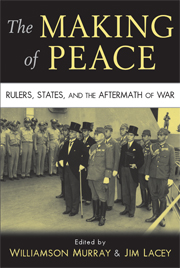Book contents
- Frontmatter
- Contents
- Preface: concluding peace
- 1 Introduction: searching for peace
- 2 The Peace of Nicias
- 3 “A swift and sure peace”: the Congress of Westphalia 1643–1648
- 4 The Peace of Paris, 1763
- 5 In search of military repose: the Congress of Vienna and the making of peace
- 6 War and peace in the post–Civil War South
- 7 Vae victoribus: Bismarck's quest for peace in the Franco-Prussian War, 1870–1871
- 8 Versailles: the peace without a chance
- 9 “Building buffers and filling vacuums”: Great Britain and the Middle East, 1914–1922
- 10 Mission improbable, fear, culture, and interest: peace making, 1943–1949
- 11 The economic making of peace
- 12 Ending the Cold War
- 13 Conclusion: history and the making of peace
- Index
- References
13 - Conclusion: history and the making of peace
Published online by Cambridge University Press: 05 June 2012
- Frontmatter
- Contents
- Preface: concluding peace
- 1 Introduction: searching for peace
- 2 The Peace of Nicias
- 3 “A swift and sure peace”: the Congress of Westphalia 1643–1648
- 4 The Peace of Paris, 1763
- 5 In search of military repose: the Congress of Vienna and the making of peace
- 6 War and peace in the post–Civil War South
- 7 Vae victoribus: Bismarck's quest for peace in the Franco-Prussian War, 1870–1871
- 8 Versailles: the peace without a chance
- 9 “Building buffers and filling vacuums”: Great Britain and the Middle East, 1914–1922
- 10 Mission improbable, fear, culture, and interest: peace making, 1943–1949
- 11 The economic making of peace
- 12 Ending the Cold War
- 13 Conclusion: history and the making of peace
- Index
- References
Summary
In a fascinating book, first published in 1973, that received too little attention, Australian economic historian, Geoffrey Blainey, examined various theories advanced in the past to explain how wars begin and why they end. Most, he found, fail historical confirmation. The one consistent pattern emerging from his research was that armed conflict ensued when antagonists disagreed about their relative strength and ended only with the resolution of that disagreement. “War,” he concluded wryly, “is a dispute about measurement.”
Of course, it is much more than that. The timeless motives of “fear, honor, and interest” described so eloquently by Professor Gray's analysis of the Cold War also animated in differing measure every other conflict discussed in this book. But in one way, at least, those conflicts also tend to verify Blainey's conclusion, for they suggest that a settlement that fails in a convincing way to resolve the question of relative power tends merely to invite another war. The well-known Clausewitzian admonition that statesmen and generals should never allow war to dictate its own logic must thus be reconciled with the need to achieve a settlement that is not only politically acceptable but strategically durable as well.
The issue of durability, however, inevitably introduces definitional problems. What does it mean to speak of a durable peace? How peaceful must it be? How long must it endure?
- Type
- Chapter
- Information
- The Making of PeaceRulers, States, and the Aftermath of War, pp. 356 - 368Publisher: Cambridge University PressPrint publication year: 2008

